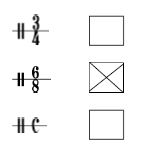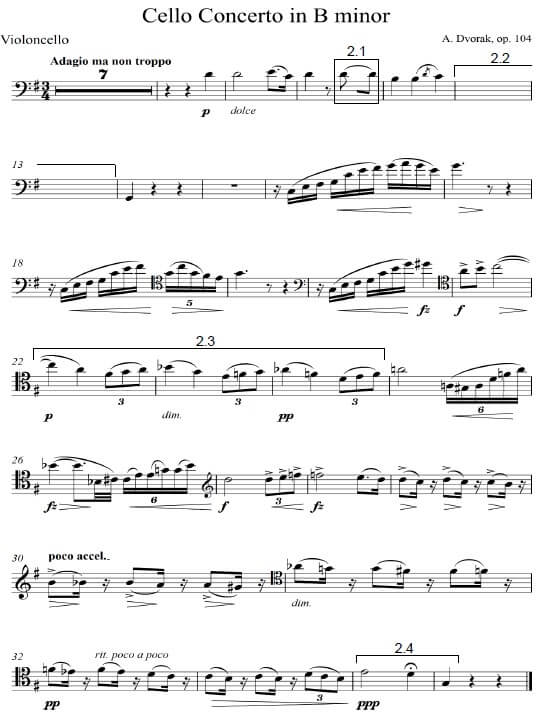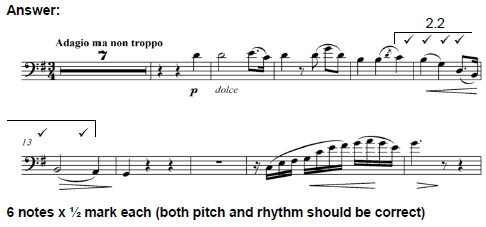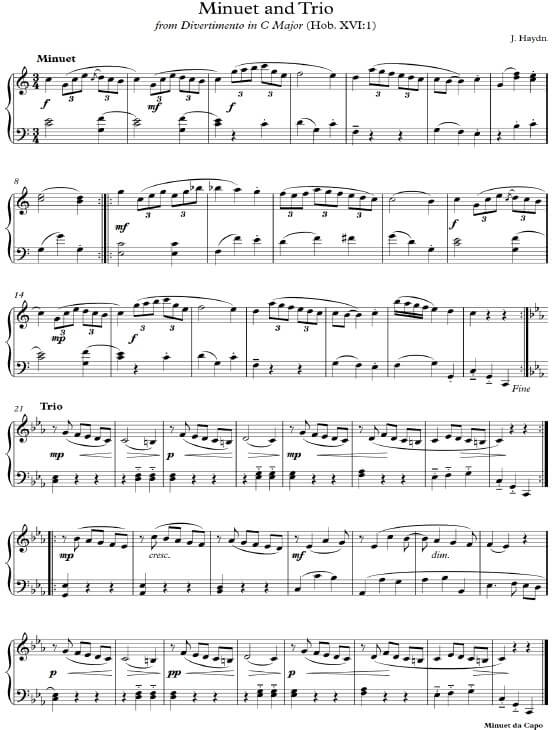MUSIC PAPER 2 GRADE 12 MEMORANDUM - NSC PAST PAPERS AND MEMOS SEPTEMBER 2016
Share via Whatsapp Join our WhatsApp Group Join our Telegram GroupMUSIC
PAPER TWO (P2)
GRADE 12
EXAM PAPERS AND MEMOS
SEPTEMBER 2016
MEMORANDUM
SECTION A: AURAL
QUESTION 1 (COMPULSORY)
| Play Track 1 THREE times. Pause for 30 seconds in between. |
1.1 Listen to the melodic and rhythmic phrase. Notate the rhythm of the missing notes in bars 2–3 below. 
| Play Track 1 ONCE more. |
| Play Track 2 TWICE in succession. |
1.2 Make a cross (X) in the block next to the correct time signature of this extract.
[4]
QUESTION 2 (COMPULSORY)
| Play Track 3 ONCE to provide a general overview. |
Listen to the extract from the second movement of Cello Concerto, Op. 104 by A. Dvořák. Answer the questions that follow. 
| Play Track 4 TWICE. |
2.1 Name the interval at 2.1, for example Major 3rd.
Answer: Perfect 4th (1)
| Play Track 4 FOUR times. Pause ONE minute between each repetition. |
2.2 Fill in the missing notation at 2.2 in bars 12 and 13. (3) 
| Play Track 5 ONCE. |
2.3 Identify the compositional technique used at 2.3 in bars 22–24.
Answer: Sequences (1)
| Play Track 6 TWICE. |
2.4 Name the cadence used at 2.4.
Answer: Perfect Cadence (1)
[6]
TOTAL SECTION A: 10
SECTION B: RECOGNITION OF MUSIC CONCEPTS
QUESTION 3: GENERAL LISTENING (COMPULSORY)
Mark THREE items in COLUMN A in QUESTIONS 3.1–3.4 that relate to the music that you hear. Make a cross (X) in THREE appropriate blocks.
3.1 (3)
| Play Track 7 TWICE. |
COLUMN A | Track 7 |
Homophonic Texture | X |
Baroque Period | |
Concerto | X |
Polyphonic Texture | |
Classical Period | X |
Piano Sonata |
3.2 (3)
| Play Track 8 TWICE. |
COLUMN A | Track 8 |
Primary chords | |
A cappella | X |
Polyrhythm | |
Parallel intervals | X |
Ankle rattles | |
Call and response | X |
3.3 (3)
| Play Track 9 TWICE. |
COLUMN A | Track 9 |
Piano | |
Pennywhistle | |
Township Jive | X |
Accordion | X |
Syncopation | X |
Mbaqanga |
3.4 (3)
| Play Track 10 TWICE. |
COLUMN A | Track 10 |
Suspensions | X |
Irregular metre | |
Minor key | X |
Regular metre | X |
Adagio | |
Timpani |
(12 ÷ 3) [4]
Answer QUESTION 4 (WAM) OR QUESTION 5 (JAZZ) OR QUESTION 6 (IAM).
QUESTION 4: WAM
4.1
| Play Track 11 ONCE. |
4.1.1 Identify the brass instrument playing at the beginning of this extract.
Answer: French Horn (1)
| Play Track 11 ONCE again. |
4.1.2 Describe this work with regard to genre, tempo and time signature.
Genre: Symphony (one mark)
Tempo: Allegretto (one mark)
Time signature: 6/8 OR compound duple (one mark) (3)
4.1.3 Provide this extract with a suitable title.
Answer: Shepherds’ Song (1)
4.2
| Play Track 12 ONCE. |
4.2.1 Identify ONE woodwind and ONE string instrument that plays the melody at the beginning of this extract.
Woodwind instrument: Bassoon (one mark)
String instrument: Cello (one mark) (2)
4.2.2 With which ONE of the following genres do you associate this extract? Make a cross (X) in the appropriate block. (1)
![]()
| Play Track 12 ONCE again. |
4.2.3 Identify the composer and give a title for this work.
Composer: Mendelssohn (one mark)
Title: Fingal’s Cave OR The Hebrides Overture (one mark) (2)
4.3
| Play Track 13 TWICE. |
4.3.1 Which style of composition that was predominantly used during the Baroque period is evident in this extract?
Answer: Fugal exposition OR Fugue (1)
4.3.2 Name the subgenre in opera music that is associated with this extract.
Answer: Overture (1)
4.3.3 Identify the composer of this work.
Make a cross (X) in the appropriate block. (1)![]()
4.4
| Play Track 14 TWICE. |
Mark THREE items in COLUMN A that is related to Track 14.
Make a cross (X) in THREE appropriate blocks. (3)
COLUMN A | Track 14 |
Pamina and Papageno | X |
Allegro assai | |
Papageno and Papagena | |
Andantino | X |
Sarastro and chorus | |
Recitative | |
Larghetto | |
Duet | X |
(16 ÷ 2) [8]
OR
QUESTION 5: JAZZ
5.1
| Play Track 15 TWICE. |
5.1.1 Identify the woodwind instrument playing in this extract.
Answer: Clarinet (1)
5.1.2 Identify the South African jazz style.
Answer: Marabi (1)
5.1.3 Name the group that you associate with this extract.
Answer: Manhatten Brothers (1)
5.2
| Play Track 16 TWICE. |
5.2.1 Identify the South African jazz style.
Answer: New Jazz (1)
5.2.2 Give TWO reasons to motivate your answer to QUESTION 5.2.1.
- Featured South African musicians Dollar Brand, Kippie Moeketsi, Jonas Gwangwa and Hugh Masekela all destined to shape South African jazz (one mark)
- Influences of American modern jazz (Bebop) mixed with a more distinctively South African sound (one mark) (2)
| Play Track 16 TWICE. |
5.2.3 Describe the music with regard to typical rhythmical features and time signature(s).
Rhythm: Syncopation
Time signature: Simple quadruple to simple triple (2)
5.2.4 Identify the group performing this work.
Answer: The Jazz Epistles (1)
5.3 Play Track 17 TWICE.
5.3.1 Identify the style and artist that can be heard in this extract.
Answer: Style: Early Jazz (one mark)
Artist: Dolly Rathebe (one mark) (2)
5.3.2 Name ONE chordophone and ONE electrophone instrument featured in this extract.
Chordophone: Piano
Electrophone: Electric Guitar (2)
5.4
| Play Track 18 TWICE. |
Mark THREE items in COLUMN A that is related to Track 18. Make a cross (X) in THREE appropriate blocks. (3)
COLUMN A | Track 18 |
Piano improvisation | |
Blues Notes Band | X |
Dollar Brand | |
Cape Jazz | |
Trumpet improvisation | X |
Brotherhood of Breath | |
Kwela | |
Jazz in exile | X |
(16 ÷ 2) [8]
OR
QUESTION 6: IAM
6.1
| Play Track 19 TWICE. |
6.1.1 Identify the type of African song associated with this extract. Make a cross (X) in the appropriate block.
![]()
6.1.2 Identify ONE vocal technique used in this extract.
Answer: Ululation (1)
6.1.3 Which voice group performs this song?
Answer: Men OR Tenor and Bass (1)
6.2
| Play Track 20 ONCE. |
6.2.1 Identify the South African style.
Answer: Isicathamiya (1)
| Play Track 20 ONCE. |
6.2.2 Describe the instrumentation used in this extract.
Answer: Male voices (one mark)
singing a capella music (one mark) (2)
6.2.3 Identify the group performing in this extract.
Answer: Ladysmith Black Mambazo (1)
6.3
| Play Track 21 ONCE. |
6.3.1 Name and define the style that you hear in this extract.
Answer: Maskanda/Maskandi (one mark)
Virtuoso instrumentalist playing traditional music on Western instruments (one mark) (2)
6.3.2 With which African tribe do you associate this music?
Make a cross (X) in the appropriate block.![]()
| Play Track 21 ONCE. |
6.3.3 Identify ONE prominent chordophone instrument used in this extract.
Answer: Acoustic Guitar (1)
6.3.4 Why is this South African style so closely related to Blues?
Answer: Because of the cyclical, repetitive (one mark) and picking of strings on the guitar (one mark) (2)
6.4
| Play Track 22 TWICE. |
Mark THREE items in COLUMN A that is related to Track 22. Make a cross (X) in THREE appropriate blocks. (3)
COLUMN A | Track 22 |
Djembe | |
Polyrhythm | X |
Philip Tabane | |
Monophonic | |
Free Kiba | X |
Tabla drums | |
Sello Galane | X |
vhaVenda drums |
(16 ÷ 2) [8]
TOTAL SECTION B: 12
QUESTION 7 (COMPULSORY)
Read and study the questions for ONE minute.
| Play Track 23 ONCE to provide an overview. |
| Play Track 23 ONCE again. |
7.1 Name the overall form of this work.
Answer: Compound Ternary Form OR Minuet and Trio Form (1)
7.2 Give an analysis of the form of the Minuet.
Minuet: (9 ÷ 3) (3)
SECTION | BARS | MAIN KEYS |
A | 1–8 | C major |
B | 9–12 | F–G major |
A1 | 13–20 | C major |
7.3 Give an analysis of the form of the Trio.
Trio: (9 ÷ 3) (3)
SECTION | BARS | MAIN KEYS |
C | 21–28 | C minor |
D | 29–35 | Eb major |
C1 | 36–43 | C minor |
7.4 How is the key of the Trio related to the key of the Minuet?
Answer: Parallel key (C major – C minor) (1)
| Play Track 23 one last time. |
TOTAL SECTION C: 8
GRAND TOTAL: 30